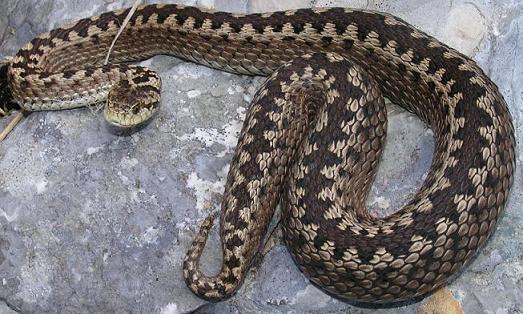|
|
Planinski žutokrug |
Vipera ursinii macrops |
Orsini's Viper |
|
|||
|
|||||||
|
GDJE: Dinara, J Velebit |
Opis: |
Description: |
WHERE: Dinara, S Velebit |
||||
|
- neki autori svrstavaju planinskog žutokruga kao zasebnu vrstu: Vipera macrops, ali to nije tako.
|
Stanište: Planinski žutokrug je planinska forma Sreće ih se na visinama preko 1 000 m nadmorske visine. Živi na brdima s dobrom "drenažom", nešto vegetacije, ali češće na visokim često suhim, livadama. |
Habitat: V. u. macrops is a mountain form, occuring above 1000 m above sea level. Lives on well drained hill sides with some vegetation, but more often encountered on high, often dry, meadows. |
- some authors regard them as a separate species: Vipera macrops, but that isn't true.
|
||||
|
Ponašanje: Planinski žutokrug je pomalo živčana zmija (a tko ne bi bio da ima manje od 100g i nešto ogromno ti ne da mira?), hoće gristi ako ga se uznemirava. U neuznemirenim staništima može biti relativno česta (ali to je ipak rijetko u usporedbi s ostalim vrstama). |
Behaviour: The Karst Meadow Viper is a somewhat nervous snake (and who wouldn't be when you weigh less than 100g and something enormous just won't leave you alone?), will bite if molested. In undisturbed areas can be quite common (but that's still rare when compared to other species). |
||||||
|
Prehrana: Pretežito se hrani skakavcima (našlo se i do 100 komada po zmiji). Plijen često guta živ rađe nego da ga otruje, ali i to se dešava. |
Food: Feeds mainly on grasshoppers (up to a hundred have been found in a single snake). Prey is often swallowed alive rather than envenomated, but that does occur. |
||||||
| - moguća je prisutnost jedinki podvrste Vipera ursinii rakosiensis (nizinska podvrsta) na granici uz Mađarsku, ali potrebna su dodatna istraživanja da bi se to potvrdilo ili opovrglo. |
Razmnožavanje:
Leže 2-5 malih. Bebe su 12-15 cm duge. |
Reproduction: V. u. macrops lays 2-5 young. Babys are 12-15 cm long. |
-
posible presence
of Vipera
ursinii rakosiensis subspecies (lowland ssp.) on the border with Hungary, but aditional research is needed to confirm or
disprove that. |
||||
|
Otrov: Slabiji od svih ostalih europskih ljutica. To, zajedno s blagim i mirnim temperamentom, čini žutokruga najmanje opasnom europskom ljuticom, ali zbog moguće zamjene s opasnijim riđovkama (V. berus berus i V. b bosniensis) ipak treba postupati prema njima s poštovanjem. Kod ljudi izaziva lokalnu bol i oticanje. U osjetljivih osoba može se javiti mučnina i povraćanje, ali oporavak je obično brz. Nisu zabilježeni smrtni slučajevi. |
Venom: Weaker than that of the other vipers. That in combination with it's placid disposition makes Orsini's Viper the least dangerous European viper, but with possible misidentification with more dangerous Adders (V. berus berus and V. b bosniensis) they should still be treated with respect. In humans, a bite causes local pain and swelling. In more sensitive persons can cause nausea and throwing up, but recovery is usually swift. No deaths have been recorded. |
||||||
|
Linkovi: www.herp.it/ (slike) |
Links: www.herp.it/ (pictures) |
||||||
